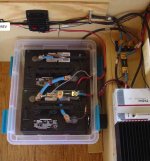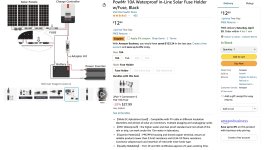Hey guys , so I’ve got 2 x 200 watt Renogy panels mounted on my converted cargo trailer, they’ll be in “ parallel” going to a branch y connector then 10 awg to a wire gland and inside, ive Heard some folks install a 30 amp fuse right after the y connector? or should it be down by the Mppt or ?
You are using an out of date browser. It may not display this or other websites correctly.
You should upgrade or use an alternative browser.
You should upgrade or use an alternative browser.
Solar panel fuse, where to put it
- Thread starter Roktman
- Start date
86scotty
Cynic
Probably not a run of more than 10' or so from panels to controller, right? Put it anywhere, just make sure and put it somewhere. I prefer them in a cabinet right by the controller.
Also, unless you've bought it already, get a 30a breaker instead of a fuse. It's very doubtful that you'll ever trip/blow it but they are still a better way to go.
Also, unless you've bought it already, get a 30a breaker instead of a fuse. It's very doubtful that you'll ever trip/blow it but they are still a better way to go.
Peter_n_Margaret
Adventurer
I suggest that it is more important to have protection near the battery on the cable from the battery to the controller.
Cheers,
Peter
OKA196 motorhome
Cheers,
Peter
OKA196 motorhome
JaSAn
Grumpy Old Man
Renogy recommends 3 fuses in your system:
Your controller manufacturer should recommend the size of fuse.

 www.renogy.com
www.renogy.com
I prefer ANL fuses: they are faster acting, simpler, cheaper, simple to disconnect. I put mine inside, next to the controller; my fuse holders are not weather tight.

- panels to controller,
- controller to battery,
- batter to distribution.
Your controller manufacturer should recommend the size of fuse.

How to Properly Fuse Your Solar System
Need to repair your solar panel? Learn how to fuse it safely and efficiently in this comprehensive guide. Discover expert tips, precautions, and step-by-step instructions for a successful DIY fix.
 www.renogy.com
www.renogy.com
I prefer ANL fuses: they are faster acting, simpler, cheaper, simple to disconnect. I put mine inside, next to the controller; my fuse holders are not weather tight.

Last edited:
workerdrone
Well-known member
If you want parallel advantage (partial shade performance) don't they have to be separate all the way to the controller?Hey guys , so I’ve got 2 x 200 watt Renogy panels mounted on my converted cargo trailer, they’ll be in “ parallel” going to a branch y connector then 10 awg to a wire gland and inside, ive Heard some folks install a 30 amp fuse right after the y connector? or should it be down by the Mppt or ?
If you want parallel advantage (partial shade performance) don't they have to be separate all the way to the controller?
No, they don't. From an electrical standpoint it doesn't really matter where the 2 panels are connected together unless you are running small wires and have to really watch voltage drops.
As for the solar fuses, I like to put them close to the controller. They only come into play if the controller goes bonkers and tries to dump the battery into the panels.
In both cases above, I'm referring to a smaller (<1000W) array and short distances like one would typically have in a vehicle or camper system. With large arrays, higher voltages, and long cable runs like you might have in a house or building solar system there are other considerations.
Last edited:
I only know the panels I own. They all came with a blocking diode that prevents current flow backwards into the panel from the battery/charge controller. An added fuse provides extra protection, but a fuse is a resistor that can develop a voltage drop/loss, and is another connection to possibly cause problems.
Once, after seeing less than normal charging, the culprit was an overheated MC4 connector. I now void the warranty by cutting off the MC4 and replacing with Anderson connectors. Andersons allow placing a voltmeter probe inside for voltage measurements. An MC4 does not.
This is not to counter manufacturers or other users advice. To each their own.
Once, after seeing less than normal charging, the culprit was an overheated MC4 connector. I now void the warranty by cutting off the MC4 and replacing with Anderson connectors. Andersons allow placing a voltmeter probe inside for voltage measurements. An MC4 does not.
This is not to counter manufacturers or other users advice. To each their own.
llamalander
Well-known member
Similar threads
- Replies
- 0
- Views
- 581
- Replies
- 0
- Views
- 795
- Replies
- 8
- Views
- 3K
- Replies
- 2
- Views
- 822

